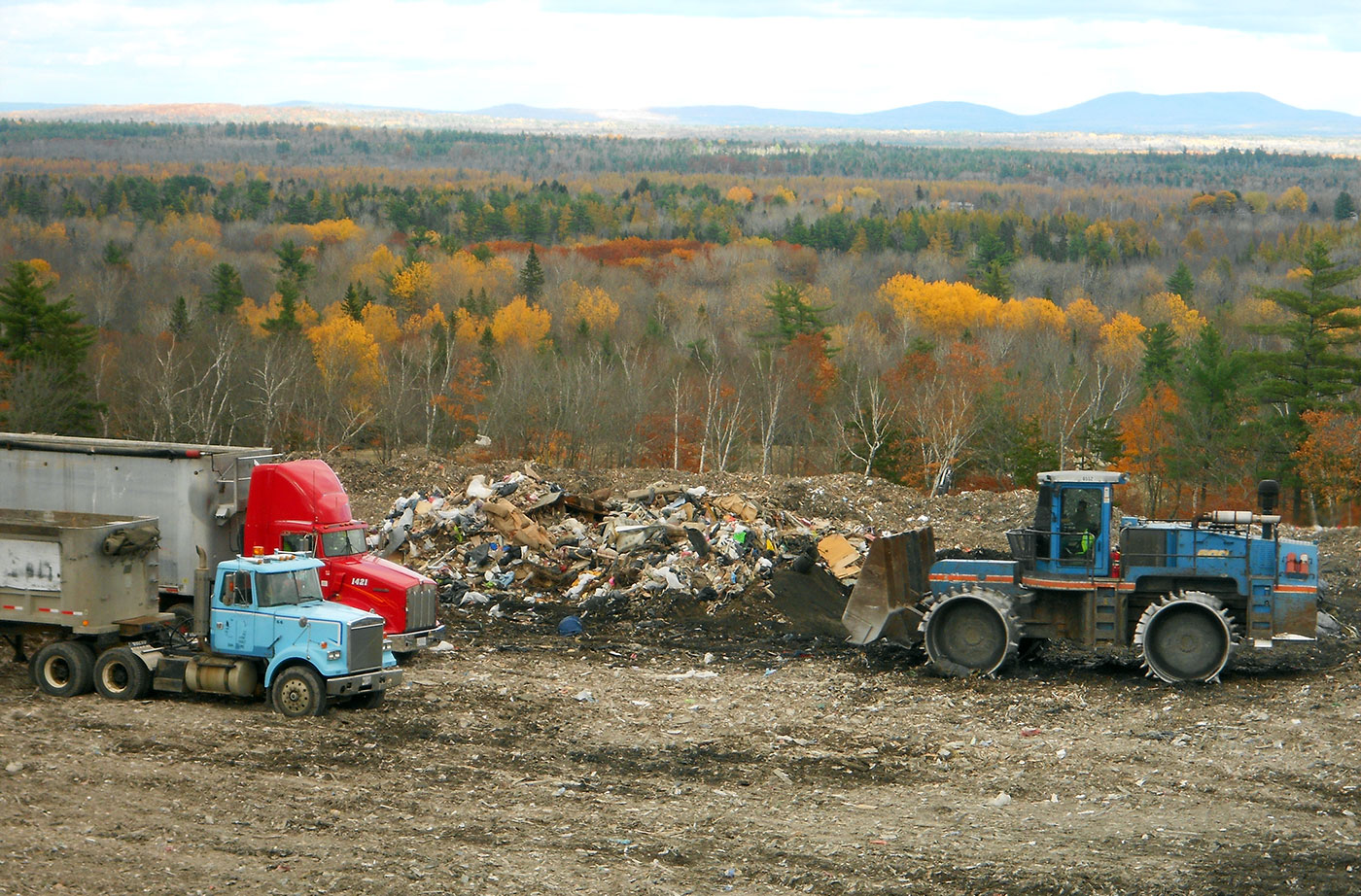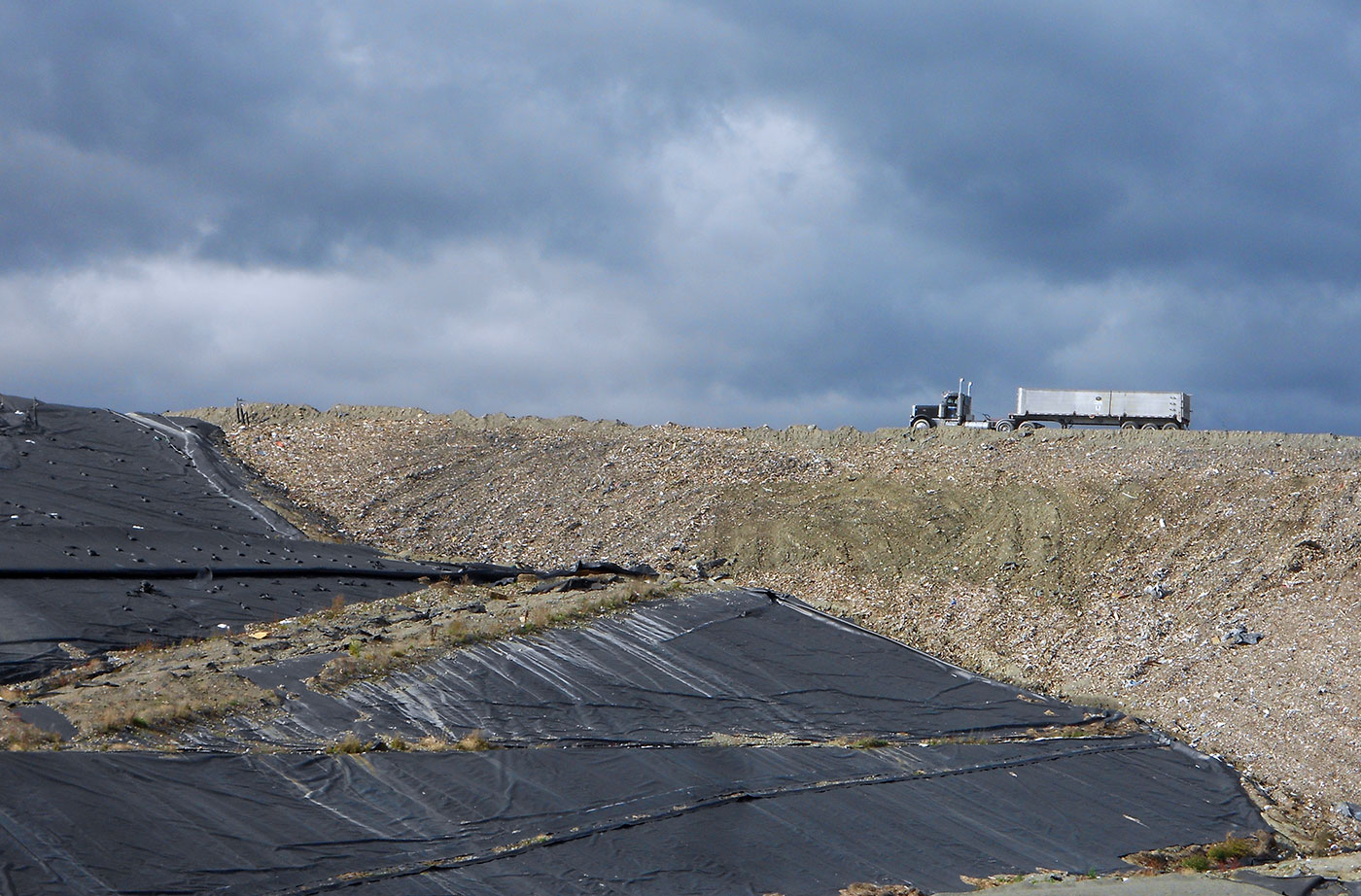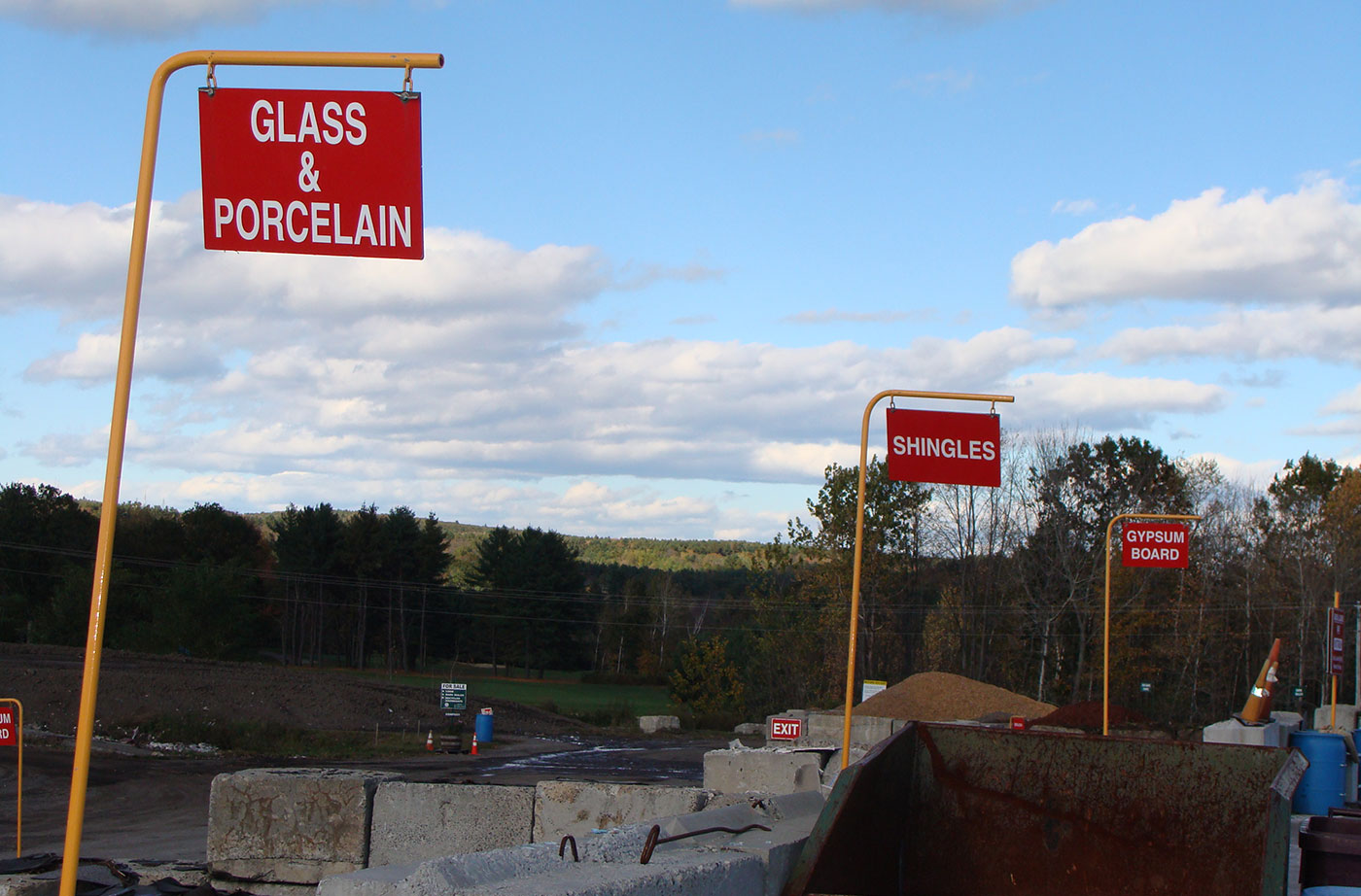There’s a hidden climate villain in Maine that you might not know about, and it’s where about 75% of our total waste goes. According to the U.S. EPA, landfills are the third-largest source of human-related methane emissions in the United States.[1] Pound for pound, methane has about 30 times more atmospheric heat-trapping capability than carbon dioxide. Mismanaged landfills in developing countries, where some of our waste ends up, are leaking plastic into our oceans. It is estimated that about 31.9 million tons of plastic are added to the ocean each year from litter and insecure landfills.[2] And the waste going into our landfills carries countless toxic, hazardous substances that can pose a serious threat to air and water in areas downwind and downstream.
How landfills are managed at home and abroad affects all of us. Let’s take a look at how they’re managed in Maine and why you should care.
When you throw something “away” in Maine, there is a 50/50 chance it is going to a landfill. The most recent available annual data shows that just about as much municipal solid waste (MSW, also known as your typical household and business trash) was ultimately buried in our landfills as was destroyed through combustion at a waste-to-energy facility.[3]
And MSW is only half of the trash story. The other half of Maine’s waste is made up of Construction and Demolition Debris (CDD) and other special types of waste. Materials like concrete, bricks, wood waste, and land clearing debris are considered CDD. Special wastes are things like incinerator ash, contaminated soils, and wastewater treatment plant sludge. A lot of this material is very toxic, with high levels of arsenic, lead, asbestos, PFAS, and mercury.
All of the MSW, CDD, and special waste that isn’t reduced, reused, or recycled has to have a place to go—it doesn’t just go “away.” We know that MSW makes up about half of our “waste disposal pie,” and about half of our MSW is destroyed through incineration. So, when you include toxic CDD and special wastes, this means that in Maine, about 75% of our total waste ends up in a landfill. That’s too much.

The Juniper Ridge landfill in Old Town, Maine. Photo by A.King/NRCM
Who owns a landfill in Maine makes all of the difference, or at least it should. There are currently seven municipally owned landfills, one active State-owned landfill, and one commercially owned landfill. Back in the 1980s and 1990s, there was a flurry of activity related to the management of landfills in the Northeast. With waste disposal bans beginning to pop up,[4] most states were concerned (Maine included) that they were going to be dumping grounds for other states’ toxic waste. The U.S. Supreme Court had ruled that individual states could not prevent the disposal of out-of-state waste at a commercially owned landfill, because it would violate the commerce clause, but they could if the State itself owned the landfill.
To make a long story short, in order to extend the operating lives of Maine’s existing landfills and lessen the need to expand or site new landfills in the state, Maine prevented any new commercial landfills from being built after 1989, and has since acquired three of its own landfills. The only one currently in operation in Maine is Juniper Ridge Landfill (JRL) located in Old Town (which primarily accepts CDD and special wastes) in Penobscot County; and at least one-third of the waste going there is from toxic waste material from out of state. This makes no sense since the taxpayers bought the landfill to prevent out-of-state waste from going into it.
Remember that Maine cannot prevent out-of-state waste from going to a commercial solid waste processing facility in the state—these are facilities you may be familiar with such as ecomaine in Portland, Penobscot Energy Recovery Company in Orrington, Maine, Waste-to energy in Auburn, and others like Aggregate Recycling Corporation in Eliot and ReEnergy in Lewiston. Each of these facilities processes the material in its own way, pulling out what resources it can, but each will have some leftover materials that need a landfill to go to. And, as Maine law currently states, any leftover waste that these facilities create is considered to be waste generated within the state, even if the original source of waste was from out of state.
This scenario has become a huge problem because the volume of waste coming to some of these commercial facilities from out of state and then re-directed to JRL is excessively high. The result is that the JRL landfill is filling at an accelerating rate, spurring the operator who profits from filling the landfill to propose expanding JRL’s capacity.[5] Since 2012, the fill-rate at JRL has increased an alarming 32%, and the 2017 disposal amounts were 40% higher than the maximum amounts anticipated in 2004.[6]
Let’s take the ReEnergy facility in Lewison, for instance. Based on its 2019 annual report, the facility accepted a total of 235,650 tons, and 91% of that tonnage came from Massachusetts or New Hampshire. Then it sent an astounding 93% of the waste, or 220,018 tons, to JRL. For reference, that is about 27% of the total tons disposed of at JRL that year. And ReEnergy is not the only solid waste processing facility that imports waste from other states and ultimately disposes of it at JRL, just the most notable. To better match the original intent of the law, Maine’s solid waste processing facilities should not be permitted to dispose of more waste in our State-owned landfills than they take in from true Maine-based sources.

Juniper Ridge landfill. Photo by A.King/NRCM
Landfills are also an environmental justice issue. The presence of a landfill in a community presents environmental hazards and risks by which the people living adjacent to the landfill are disproportionately affected. In the case of the JRL landfill, it is the neighboring Penobscot Nation and others living nearby that are bearing the brunt of these harmful impacts. Here are just some of the negative impacts associated with living near a landfill:
- Toxic groundwater and soil contamination when the landfill eventually leaks;
- Air pollution from frequent waste delivery vehicles, fugitive particulate matter, and potentially faulty or damaged landfill gas collection lines or landfill fires;
- Potential serious offsite damages in the event of inadequate stormwater management systems, should the area experience an extreme weather event, which is more and more likely due to human-caused climate disruption;
- Threat of subsidence (gradual settling or sudden drop) of underlying earth that’s beneath the weight of wasted materials, which could disrupt the underlying geology;
- Untreated leachate potentially discharged by local sewer systems into waterways;
- Local ecosystem disruption and threats to wildlife;
- Property devaluation, stigma, and negative impacts on local economic development; and
- Odor, noise, traffic, and loss of enjoyment of property.
On the flip side, we also need to recognize that facilities like ReEnergy are employers, providing local residents with much-needed jobs. Making the sweeping changes to our laws that we need to protect the people living around the landfill could, if done abruptly, potentially result in loss of jobs at the impacted facilities. It is also worth noting that landfilling is often the cheapest waste management option for a lot of materials—which is part of the reason why we are filling our landfills so quickly. So as we pursue transformational policies aimed at reducing landfilling and associated risks to people and the environment, some people or businesses may have to pay more to dispose of their waste than they are now—which tends to result in a lot of opposition lobbying pressure.
These economic realities are part of the reason why it is so tricky for decision-makers to take necessary, decisive action to protect our health and environment. And in order to prevent this recurring conundrum faced by our lawmakers, we must set up our waste system in a way that de-couples profit from the creation and disposal of waste, and instead encourages businesses to profit from waste reduction, reuse, and recycling.

Maine recycling center. Photo by A.King/NRCM
We should be doing everything possible to reduce, reuse, and recycle as much waste as we can to keep the problems associated with landfills to a minimum and conserve our limited natural resources. The State of Maine has A LOT of room for improvement in this regard. Creating a more sustainable waste management system through policy will take foresight, time, and a whole bunch of political will, but I am confident that we can succeed, especially if more people understand and care about landfills.
—Sarah Nichols, Sustainable Maine Program Director at the Natural Resources Council of Maine
[1] https://www.epa.gov/lmop/basic-information-about-landfill-gas
[2] https://advances.sciencemag.org/content/3/7/e1700782
[3] Source: Maine Department of Environmental Protection’s Maine Solid Waste Generation and Disposal Capacity Report for Calendar Year 2017, January 2019
[4] List of materials banned from disposal in Northeast states as of 2018: Construction & Demolition Debris (MA, VT); Drywall (MA, NJ, VT); Wood waste (NH); White goods (VT, MA, NY); Electronics (NH, NY, VT, CT); Food Waste (MA, CT, VT); Mixed Paper (VT, MA); Newspaper (VT, NY); Office Paper (VT, NY, MA); Cardboard (VT, NY); Paint (VT, NY, CT); Plastic Containers (VT, MA); Glass Containers (VT, MA); Steel Cans (VT, MA, NY); Aluminum (MA, VT, NY); Yard Waste (VT, MA, NY, NJ, CT); Mercury oxide batteries (CT); and Liquid Waste (NH, NY, CT).
[5] The State does not operate nor profit from the landfill; rather it has an contractual operating services agreement with New England Waste Services of Maine (NEWSME), LLC, a subsidiary of Casella Waste Systems, who assumes all of the expenses and revenues related to the landfill.
[6] Source: DEP’s January 2019 Maine Materials Management Report to the Legislature











Quite an informative, thought-provoking article. I’ll share this important information.
Funny that the article does not mention Casella Waste Systems…hopefully Maine will close that loophole that has allowed Casella and the other garbage profiteers to skirt the law and import out of state waste. Meanwhile, here in NH, we are trying to fight them off on two fronts…the Bethlehem expansion and their mega-dump right next to Forest Lake. http://www.SaveForestLake.com
Thanks for your comment, John. We are aware of Casella’s effort to benefit from landfill expansions and increased waste disposal at their many facilities; which unfortunately is completely legal under our current laws and rules. And they aren’t the only company to be profiting from importing out-of-state waste into Maine. NRCM is working hard to fix the loopholes you mentioned, and prevent this from happening in perpetuity. We need all hands on deck, thank you for doing your part!
– Sarah
Thank you for this well-written article. I agree that there is still a lot of education that needs to be done in communities regarding ways to reduce, reuse, recycle and the consequences of landfills. Many of the good junk removal companies try to recycle and donate wherever possible. Using a company comes with a fee to the consumer, so while it might be a responsible and hassle free option for individuals and businesses, it is not completely ideal from a monetary perspective. Still, more incentives to do the right thing and penalties for not need to be implemented at all levels of government. Additionally, there needs to be more conversation about this on the local level. It needs to be made a priority.
How much of the material (plastics, paper and glass) that we put in our recycling bins is actually recycled?
Hi Tom, that’s a great question, and unfortunately we don’t have a great answer. In short, it totally depends on the material and who processes it—and even then we don’t have comprehensive data following materials from collection to actual recycling. Our new EPR for Packaging law aims to retrieve that data, and works to improve the whole recycling system so that we reduce, reuse, and recycle more than we are doing now.